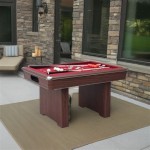How to Move a 3-Piece Slate Pool Table Without Taking It Apart
Moving a pool table is a demanding task, often complicated by its weight and delicate construction. A standard pool table features a slate playing surface, typically composed of three individual pieces. Theoretically, moving a pool table without disassembly simplifies the process. However, this approach presents significant challenges and inherent risks that must be carefully considered. This article outlines the process of attempting to move a 3-piece slate pool table without taking it apart, emphasizing the necessary precautions and factors influencing the feasibility of such a move.
The desirability of moving a pool table intact stems from avoiding the complexities, time investment, and potential for error associated with disassembly and reassembly. Disassembly requires specialized tools and a comprehensive understanding of the table's construction. Reassembly, particularly the leveling of the slate, is a precision task often requiring professional expertise. Skipping these steps by moving the table whole can seem like an efficient solution, but the potential for damage to the table or the surrounding property is substantially increased.
Assessing the Feasibility of Moving a Pool Table Intact
Before attempting to move a pool table without disassembly, a thorough assessment of the environment and the table itself is crucial. This assessment determines the practical possibility of such a maneuver and identifies potential obstacles. Several factors play a critical role:
Doorway and Pathway Dimensions: The most immediate consideration is whether the pool table, in its assembled form, can physically fit through doorways, hallways, and any other constricted spaces along the moving route. Precise measurements of the table's dimensions (length, width, and height) must be compared against the clear opening of each passage. Remember to account for maneuvering space; a doorway that is the exact width of the table will still be impassable due to the inability to angle the table during the move. Any tight turns or narrow corridors will further complicate the process and increase the likelihood of damage.
Floor Strength and Obstacles: The structural integrity of the floors along the moving path is paramount. Pool tables, especially those with 3-piece slate, are exceptionally heavy. Weak or uneven floors may not be able to support the concentrated weight, leading to potential floor damage or, more seriously, the table collapsing. Identify any fragile flooring materials (such as tile or laminate) and plan accordingly. Additionally, look for obstructions such as stairs, ramps, or uneven surfaces. Moving a heavy object across these obstacles increases the risk of tipping or dropping the table.
Table Condition and Construction: The overall condition of the pool table affects its ability to withstand the stresses of moving. Older tables may have weakened joints or deteriorated framing that could fail under the strain. The type of construction also matters. Tables with thinner slate or less robust frames are more susceptible to damage than those built with heavier-duty materials. Inspect the table carefully for any signs of structural weakness before attempting to move it.
Available Manpower and Equipment: Moving a pool table intact requires a significant amount of manpower. The number of people needed depends on the size and weight of the table, as well as the complexity of the moving route. A minimum of four strong individuals is generally recommended. Furthermore, specialized equipment such as furniture dollies, lifting straps, and protective padding is essential. Using the correct equipment reduces the risk of injury and minimizes the potential for damage to the table and the surrounding environment.
Preparing the Pool Table for the Move
If the initial assessment suggests that moving the pool table intact is feasible, preparations are necessary to secure the table and protect it from damage. This process involves several steps:
Remove Accessories: Detach all removable accessories, including the pool cues, balls, triangle, and any other items stored with the table. These items should be packed separately to prevent them from shifting during the move and potentially causing damage.
Secure Loose Components: Check for any loose components on the table, such as pockets or trim pieces. Secure these elements with tape or temporary fasteners to prevent them from detaching during the move. Ensure that the pockets are either removed or thoroughly secured to prevent tearing or damage.
Protect the Playing Surface: The slate playing surface is the most vulnerable part of the pool table. Cover it with a thick, protective material such as moving blankets or heavy-duty cardboard. Secure the covering tightly with packing tape to prevent it from shifting during the move. Extra padding at the corners is particularly important, as these areas are most susceptible to impact damage.
Wrap the Table: Wrap the entire pool table with moving blankets or plastic wrap to protect it from scratches, dents, and dust. Secure the wrapping material tightly with packing tape, ensuring that all surfaces are adequately covered. Multiple layers of wrapping provide additional protection against potential damage. Pay special attention to protecting the legs and the corners of the table, as these are the most likely points of contact during the move.
Executing the Move with Precautions
With the preparations complete, the actual move requires careful execution and constant vigilance. Safety and damage prevention should remain the top priorities throughout the process.
Use Furniture Dollies: Employ furniture dollies with non-marring wheels to move the pool table. Place the dollies strategically under the legs of the table, ensuring that they are securely positioned and can support the weight. Use furniture straps to secure the table to the dollies for added stability. The straps should be tightened firmly to prevent the table from shifting or sliding off the dollies.
Maintain Slow and Controlled Movements: Move the pool table slowly and deliberately, communicating clearly among the team. Avoid sudden starts, stops, or changes in direction, as these can destabilize the table and increase the risk of tipping. Navigate obstacles carefully, using spotters to guide the movement and ensure that the table clears any obstructions. If encountering a particularly tight space, consider removing door frames or other temporary obstructions to create more maneuvering room.
Lift, Don't Drag: Avoid dragging the pool table across the floor, as this can damage both the table and the flooring. Always lift the table slightly when repositioning it, even if only by a small amount. This prevents the legs from scraping against the floor and reduces the stress on the table's frame. When lifting, ensure that everyone involved uses proper lifting techniques to avoid back injuries.
Negotiate Stairs and Ramps Carefully: Stairs and ramps present the greatest challenge when moving a pool table intact. If possible, avoid them altogether by finding an alternative route. If stairs or ramps are unavoidable, use a ramp system designed for moving heavy objects. Ensure that the ramp is securely anchored and can support the combined weight of the table and the movers. Use multiple people to guide the table up or down the ramp, maintaining constant control and communication. Consider hiring professional movers with experience in navigating stairs and ramps with heavy objects.
Constant Monitoring: Throughout the move, continuously monitor the condition of the pool table and the surrounding environment. Look for any signs of stress or damage, such as cracks, loose joints, or scratches. Address any issues immediately to prevent them from escalating. If the table becomes unstable or the moving route proves too challenging, stop and reassess the situation. It may be necessary to partially disassemble the table to overcome a particularly difficult obstacle.
Moving a pool table without disassembly is a demanding undertaking that requires careful planning, preparation, and execution. While technically possible in certain circumstances, the risks of damage and injury are considerable. A thorough assessment of the environment and the table’s condition is essential for determining the feasibility of such a move. If the move is deemed feasible, meticulous preparation and cautious execution are necessary to minimize the potential for problems. In many cases, professional disassembly and reassembly represent the safer and more prudent course of action, despite the added cost and time investment.
Can You Move A 3 Piece Slate Pool Table Without Taking It Apart Quora
Can You Move A 3 Piece Slate Pool Table Without Taking It Apart Quora
Can You Move A 3 Piece Slate Pool Table Without Taking It Apart Quora
Can You Move A 3 Piece Slate Pool Table Without Taking It Apart Quora

How To Move A Pool Table

How To Move A Pool Table Without Taking It Apart

How To Move A Pool Table The Home Depot

How To Move A Pool Table Without Taking It Apart All Pro Billiards

How To Move A Pool Table New House Or Room Neighbor Blog

How To Move A Pool Table By Yourself Complete Step Guide
Related Posts








